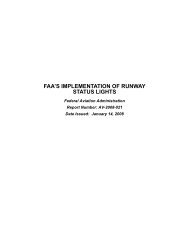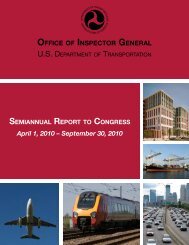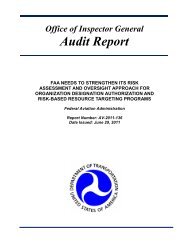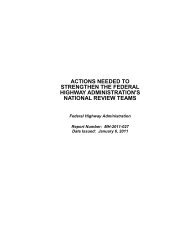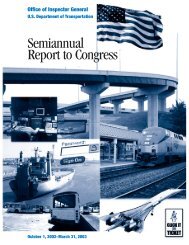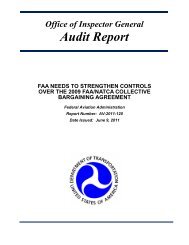Impact Magazine June 2011 - Office of Inspector General - U.S. ...
Impact Magazine June 2011 - Office of Inspector General - U.S. ...
Impact Magazine June 2011 - Office of Inspector General - U.S. ...
Create successful ePaper yourself
Turn your PDF publications into a flip-book with our unique Google optimized e-Paper software.
The Steel Expert<br />
OIG special agents met with FHWA engineers, who<br />
explained that the steel casings Appleby NW made for the Tolt<br />
River Bridge project were temporary casings. After examining<br />
the contract, it was determined that the temporary casings were<br />
not required to be Buy American-compliant. The agent asked<br />
the engineers to provide a list <strong>of</strong> projects where Appleby NW<br />
had subcontracted to make permanent steel casings, which were<br />
required to be Buy American-compliant. One such project identifed<br />
was the $2.6 billion Sound Transit Seattle Light Rail, a project<br />
not funded by the FWHA but by the Federal Transit Administration<br />
(FTA).<br />
The agent contacted FTA <strong>of</strong>fcials to obtain information<br />
about the project, especially contract specifcations, along with<br />
the steel mill tests reports to certify that the steel was melted,<br />
manufactured, and rolled in the United States. Appleby NW had<br />
supplied permanent shaft casings used to form and support the<br />
concrete foundations for the elevated portions <strong>of</strong> the project’s<br />
4-mile track. The company provided approximately 150 casings,<br />
ranging in size from 9- to 12-feet high and approximately 12 feet<br />
in diameter. FTA <strong>of</strong>fcials suggested that the agent could get the<br />
mill test reports that Appleby NW had gotten from its supplier<br />
when the steel was purchased. It was a requirement <strong>of</strong> the contract<br />
that these reports be submitted to Sound Transit as pro<strong>of</strong> the<br />
steel met contract specifcations.<br />
A few days later, Sound Transit provided the agent with<br />
hundreds <strong>of</strong> mill test reports it received from various contractors<br />
for steel used on the project. Thirty-six mill test reports received<br />
in 2005 and 2006 were for the steel shaft casings Appleby NW had<br />
made for the project. Sound Transit also gave the agent a letter<br />
from Appleby NW’s steel supplier dated September 7, 2005, that<br />
appeared to have been written to indicate the steel used met the<br />
project specifcations.<br />
The agent closely examined the mill test reports, but according<br />
to everything he had been told by several expert engineers<br />
about what to look for in the reports, nothing looked out <strong>of</strong><br />
the ordinary. The reports indicated that the steel was manufactured,<br />
made, and rolled in the United States. The steel met the<br />
tensile and yield strengths as required by the contract specifcations,<br />
and the certifcations were all signed by a representative<br />
from the steel supplier.<br />
IMPACT <strong>Magazine</strong> • <strong>June</strong> <strong>2011</strong><br />
TRANSPORTATION SAFETY CRIMES<br />
Former Appleby NW employees were interviewed, but<br />
none <strong>of</strong> them provided information to corroborate the allegations.<br />
The agent told his supervisor, “My gut tells me something’s up<br />
with these, but I don’t think it’s a Buy America issue. I’m starting<br />
to think, though, if there is fraud here, I’m going to have to<br />
become a steel expert to fnd it.”<br />
Things Are Not as They Appear<br />
In February 2008, Appleby NW’s steel supplier was<br />
served with an <strong>Inspector</strong> <strong>General</strong> subpoena that required it to<br />
submit the certifed mill test reports and invoices for any steel<br />
purchased by Appleby NW from January 2005 to December<br />
2006. The agent wanted to compare the reports with the ones<br />
previously received from Sound Transit. On the day the supplier<br />
received the subpoena, the agent received a telephone call<br />
from the company’s attorney. The attorney wanted to know if his<br />
client was the target <strong>of</strong> an OIG investigation and why the agent<br />
wanted these particular documents. The agent explained that he<br />
was looking into allegations regarding Buy American compliance.<br />
The attorney told him that his client had regularly sold Appleby<br />
NW Buy American-compliant steel, and that his client would<br />
comply with the subpoena request.<br />
Within a few weeks, the agent got a package from<br />
Appleby NW’s steel supplier containing numerous pages <strong>of</strong><br />
invoices as well as mill test reports. The attorney was right.<br />
From the sheer volume <strong>of</strong> documents received, it appeared that<br />
Appleby was a regular customer <strong>of</strong> his client. It took several days<br />
to fnd the 36 mill test reports and invoices that corresponded<br />
with those received from Sound Transit. As the agent compared<br />
and contrasted each mill test report, he quickly realized there was<br />
a problem.<br />
The 36 mill test reports received from Sound Transit and<br />
the ones received from the steel supplier were identical except in<br />
one detail: the physical properties for yield strength on the mill<br />
test reports received from Sound Transit appeared to have been<br />
altered to refect a yield strength psi <strong>of</strong> 50,000 or above. The steel<br />
supplier’s report indicated a yield strength psi <strong>of</strong> 36,000. All <strong>of</strong><br />
the mill test reports the prime contractor provided to Sound Transit<br />
had been altered in this way, but by whom exactly and why?<br />
Was it the prime contractor, Appleby NW, or the grant recipient,<br />
or was there a conspiracy between some or all <strong>of</strong> them? The agent<br />
didn’t know, but decided a meeting with FTA was in order and<br />
29



